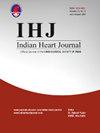A study of intracoronary thrombolytic agents in high thrombus burden lesions during primary PCI
IF 1.8
Q3 CARDIAC & CARDIOVASCULAR SYSTEMS
引用次数: 0
Abstract
Objectives
High thrombus burden during Primary Percutaneous Coronary Intervention begets poor outcomes; there are several lacunas in the management of those patients.- The purpose of this study is to analyse the long-term outcomes of patients undergoing primary percutaneous coronary intervention with high thrombus burden, treated with intracoronary thrombolysis as an adjunctive therapy.
Methods
In this prospective observational study, 108 consecutive primary percutaneous coronary intervention patients with high thrombus burden were stratified into two groups basing on whether they received intracoronary thrombolytic agent before stent implantation. The primary outcome is Net Adverse Clinical Events. Secondary outcomes include Major Adverse Cardiac Events, and all other individual components of the Net Adverse Clinical Events when analysed separately.
Results
The primary outcome events occurred in 21 patients (26 %) in the Primary stent group (n = 80), whereas it occurred in 2 patients (6 %) in the primary intra-coronary thrombolysis group (n = 28), this study shows that there is no difference in primary endpoints in both groups (26 % Vs 7 %, p-value – .042, Hazard ratio - 2.56; 95 % CI - .76–8.57), however Kaplan–Meier event-free survival curves show that both the curves are well separated apart even at the end of the one year of follow – up.
Conclusion
There is no difference in the primary outcome events in both groups, however there was a consistent increase in events in the primary stent group over the one-year follow-up period. These findings suggest the need for a larger randomized clinical trial to confirm and further elucidate these results.
首次PCI术中高血栓负荷病变冠状动脉内溶栓药物的研究
目的:原发性经皮冠状动脉介入治疗时血栓负担高,预后差;在对这些病人的管理中存在一些空白。-本研究的目的是分析接受初级经皮冠状动脉介入治疗且血栓负担高、冠状动脉内溶栓作为辅助治疗的患者的长期预后。方法:在这项前瞻性观察研究中,108例血栓负荷高的连续经皮冠状动脉介入治疗患者根据支架植入前是否接受冠状动脉内溶栓治疗分为两组。主要终点是净不良临床事件。次要结局包括主要不良心脏事件,以及单独分析净不良临床事件的所有其他单独组成部分。结果:初级支架组(n=80)发生了21例(26%)的主要结局事件,而初级冠状动脉内溶栓组(n=28)发生了2例(6%)的主要结局事件,本研究显示两组的主要终点无差异(26% Vs 7%, p值- 0.042,风险比- 2.56;95% CI - 0.76 - 8.57),然而Kaplan-Meier无事件生存曲线显示,即使在一年的随访结束时,这两条曲线也被很好地分开。结论:两组的主要结局事件没有差异,但在一年的随访期间,支架组的事件一致增加。这些发现表明需要更大的随机临床试验来证实和进一步阐明这些结果。
本文章由计算机程序翻译,如有差异,请以英文原文为准。
求助全文
约1分钟内获得全文
求助全文
来源期刊

Indian heart journal
CARDIAC & CARDIOVASCULAR SYSTEMS-
CiteScore
2.60
自引率
6.70%
发文量
82
审稿时长
52 days
期刊介绍:
Indian Heart Journal (IHJ) is the official peer-reviewed open access journal of Cardiological Society of India and accepts articles for publication from across the globe. The journal aims to promote high quality research and serve as a platform for dissemination of scientific information in cardiology with particular focus on South Asia. The journal aims to publish cutting edge research in the field of clinical as well as non-clinical cardiology - including cardiovascular medicine and surgery. Some of the topics covered are Heart Failure, Coronary Artery Disease, Hypertension, Interventional Cardiology, Cardiac Surgery, Valvular Heart Disease, Pulmonary Hypertension and Infective Endocarditis. IHJ open access invites original research articles, research briefs, perspective, case reports, case vignette, cardiovascular images, cardiovascular graphics, research letters, correspondence, reader forum, and interesting photographs, for publication. IHJ open access also publishes theme-based special issues and abstracts of papers presented at the annual conference of the Cardiological Society of India.
 求助内容:
求助内容: 应助结果提醒方式:
应助结果提醒方式:


